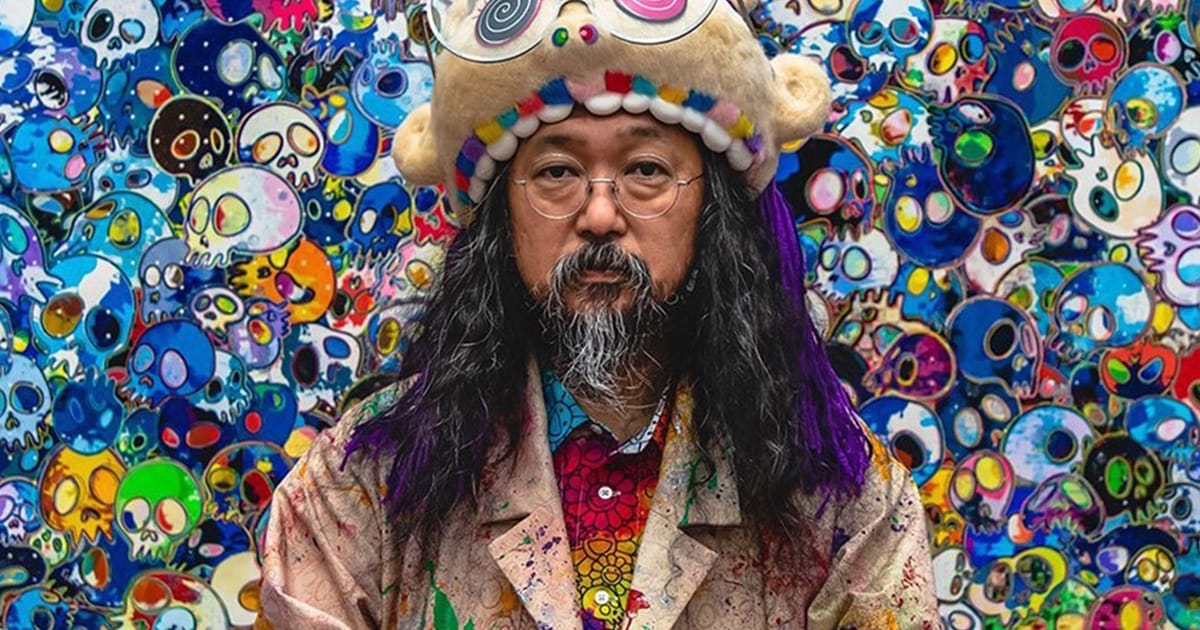Takashi Murakami: a name synonymous with vibrant colors, whimsical characters, and a groundbreaking artistic style that blends traditional Japanese art with the infectious energy of pop culture. But who is the man behind the whimsical mushrooms and smiling flowers? Let’s delve into the captivating world of Takashi Murakami, exploring his iconic works, his cultural influence, and the unique perspective he brings to the world of contemporary art.
Facts About Takashi Murakami
Takashi Murakami, often dubbed the “Warhol of Japan,” is more than just a painter – he’s a cultural phenomenon. Born and raised in Tokyo, his artistic journey began with classical Japanese painting techniques, but he quickly felt a pull towards a more contemporary, even subversive, form of expression. This led him to develop his signature “Superflat” style, a movement that challenges the traditional hierarchies of art by blending “high” and “low” culture. Imagine intricate, centuries-old Japanese woodblock prints colliding headfirst with the flashy, colorful world of anime, manga, and street art.
This blurring of boundaries extends beyond his canvases. Murakami fearlessly dives into the world of high fashion, collaborating with luxury brands like Louis Vuitton to create iconic handbags and apparel that have graced runways and magazine covers worldwide. These collaborations sparked conversations, and some controversy, challenging the traditional boundaries between art and commerce. Does collaborating with a luxury brand compromise artistic integrity, or does it open up new avenues for creative expression and cultural exchange?
Beyond the vibrant colors and playful characters, Murakami’s work explores complex themes like globalization, consumerism, and the often-overwhelming speed of technological advancement. His art reflects the world we live in – a world saturated with information, imagery, and a constant blending of cultures. He invites us to question our perceptions of art, beauty, and the things we value in a rapidly changing world.
But Murakami isn’t just an artist; he’s also a passionate advocate for his fellow artists. In 2001, he founded Kaikai Kiki Co. Ltd., a company dedicated to nurturing emerging Japanese artists and promoting their work to a global audience. Through exhibitions, collaborations, and mentorship, Murakami has played a pivotal role in bringing Japanese contemporary art to the forefront of the international art scene.
What is an Interesting Fact About Takashi Murakami?
Beyond being a highly successful artist, Murakami is known for blurring the line between art and consumerism in a way few others have achieved. He draws inspiration from everyday Japanese pop culture – from the whimsical world of Hello Kitty to the intricate details of Edo-period woodblock prints. He takes these familiar images and transforms them, twisting and remixing them to create something entirely new and undeniably his own.
At the heart of Murakami’s artistic vision lies the “Superflat” movement, a term he coined to describe a new aesthetic emerging from postwar Japan. Superflat celebrates the flatness of images, particularly in Japanese art, animation, and graphic design. It’s a rejection of Western artistic conventions that emphasize depth and perspective, instead embracing the bold outlines, vibrant colors, and two-dimensional aesthetic of Japanese visual culture.
One can’t discuss Murakami without mentioning his iconic character, Mr. DOB. This cheerful, cartoonish figure, with its wide, toothy grin and petal-like ears, is a recurring motif in Murakami’s work. Some interpret Mr. DOB as a symbol of Japan’s postwar identity – a fusion of cuteness (kawaii) and the lingering trauma of war.
And speaking of recurring motifs, flowers are another hallmark of Murakami’s style. These aren’t your grandmother’s delicate blossoms, however. Murakami’s flowers are bold, graphic, and often depicted in a seemingly endless repetition, covering entire canvases with their cheerful, almost hypnotic presence. While their vibrant colors and seemingly simple forms are undeniably appealing, they also hint at deeper themes of life, death, and the ephemeral nature of beauty.
What is Takashi Murakami’s Most Famous Piece?
While Murakami has created a vast and diverse body of work, his most iconic piece is arguably My Lonesome Cowboy (1998). This larger-than-life sculpture embodies everything that defines Murakami’s style: the “Superflat” aesthetic, the blending of high and low culture, and the juxtaposition of cuteness with a hint of the grotesque.
The sculpture depicts a young, anime-inspired boy, naked and frozen mid-stride, with an exaggerated jet of semen arcing from him like a lasso. The work is both playful and unsettling, challenging viewers to confront taboos surrounding sexuality and bodily functions. It’s a prime example of Murakami’s ability to provoke thought and spark conversation through his art.
My Lonesome Cowboy cemented Murakami’s status as a major figure in the contemporary art world, solidifying his signature style and his willingness to challenge conventional notions of what art should be. While it might not be everyone’s cup of tea, it’s a piece that stays with you, sparking curiosity and challenging you to look beyond the surface.
How Many Pieces of Art Has Takashi Murakami Made?
Given the sheer volume of Takashi Murakami’s output – spanning paintings, sculptures, prints, films, fashion collaborations, and even commercial products – putting an exact number on his total artistic output is a daunting, if not impossible, task. It would be like counting grains of sand on a beach!
His career spans decades, and his creative energy seems boundless. From massive, museum-filling installations to limited-edition prints and collectible figurines, Murakami’s art exists in a dizzying array of forms and contexts. While we may never have a definitive answer to the question of how many pieces he’s created, one thing is certain: his artistic impact is immeasurable.
Does Takashi Murakami Like Anime?
To ask if Takashi Murakami likes anime is like asking if a fish likes water. Anime and manga are not just influences on his work; they are deeply intertwined with his artistic DNA. Growing up in postwar Japan, surrounded by these vibrant and imaginative art forms, Murakami absorbed their aesthetics and themes, incorporating them into his own unique visual language.
From the large eyes and exaggerated features of his characters to the bold outlines and vibrant color palettes he employs, anime’s influence on Murakami’s work is undeniable. He embraces the energy and visual language of anime and manga, elevating them to the realm of fine art and challenging traditional notions of what constitutes “high” culture.
But Murakami’s relationship with anime goes beyond mere aesthetics. He uses these familiar visual tropes to explore complex themes of Japanese identity in a rapidly globalizing world. His work often touches upon the tensions between traditional values and the influx of Western culture, particularly through the lens of consumerism and technology.
It’s safe to say that Takashi Murakami doesn’t just “like” anime – he recognizes its power as a cultural force and harnesses it to create art that is both visually stunning and intellectually stimulating. He’s a master of bridging worlds, taking something as ubiquitous as anime and using it to spark conversations about culture, identity, and the human condition.
What is a Fact About Murakami?
One of the most intriguing aspects of Murakami’s career is his audacious blending of high art with high fashion. While collaborations between artists and fashion brands are nothing new, Murakami’s partnerships have been particularly impactful, challenging traditional perceptions of both worlds. His collaborations with Louis Vuitton, for example, weren’t just about slapping a recognizable print on a handbag; they were full-blown creative dialogues that pushed the boundaries of fashion and art alike.
These ventures thrust Murakami into the global spotlight, sparking debates about the commercialization of art and the role of consumerism in contemporary culture. Some critics accused him of “selling out,” while others praised his ability to navigate the often-murky waters of art and commerce while maintaining his artistic integrity. Love it or hate it, there’s no denying that Murakami’s foray into the world of high fashion has blurred the lines between creativity, consumerism, and cultural commentary in a way that continues to fascinate and provoke.
How Did Murakami Get Famous?
Murakami’s rise to fame is a testament to his unique ability to tap into the zeitgeist, capturing the energy and anxieties of a rapidly changing world through a visually arresting artistic language. He didn’t play by the traditional rules of the art world; he created his own.
His “Superflat” aesthetic, with its bold embrace of Japanese pop culture, was a breath of fresh air in an art world that often seemed obsessed with irony and detachment. Murakami’s art was fun, accessible, and undeniably cool, drawing inspiration from sources typically relegated to the realm of “low” culture – anime, manga, video games, and the vibrant world of Tokyo street fashion.
But beneath the bright colors and playful characters lay a sharp commentary on contemporary society. Murakami’s work explored themes of globalization, consumerism, and the rapid technological advancements that were transforming the world around him. He wasn’t afraid to tackle complex, sometimes uncomfortable, topics, but he did so with a playful, even subversive, wink.
And then there were the collaborations. By partnering with fashion behemoths like Louis Vuitton and musicians like Kanye West, Murakami strategically inserted his art into spaces far beyond the traditional confines of museums and galleries. He understood that art could, and should, exist in the everyday world, reaching people in unexpected and engaging ways.
Murakami’s success wasn’t just about talent; it was about strategy, a keen understanding of the cultural landscape, and a willingness to break down barriers between high art and popular culture. He didn’t wait for the art world to embrace him; he built his own world and invited everyone in.
You Might Also Be Interested In:
So you’re curious about influential personalities and their lives as well? For more facts about Ferdinand Berthier, you can read through and discover his greatest accomplishments.
And if you’re interested in civil rights leaders, check out these fun facts about Coretta Scott King!











